The Weather and the Moon
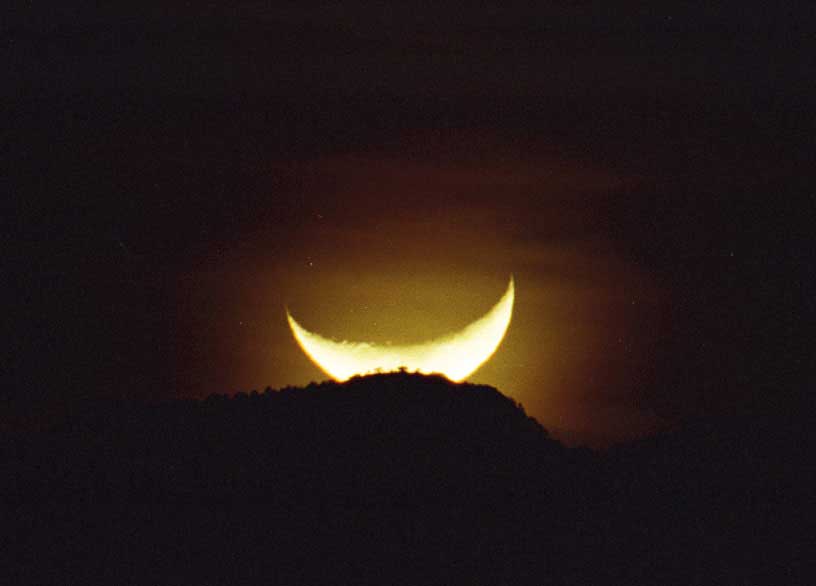 For many centuries she's a
source of inspiration: The Moon. A reliable beacon during the nightly
hours; always makes lovers' hearts beat faster and the moon can even
make you crazy -- so they say. And much more is ascribed to the
moon; according to lots of proverbs her colour and her
changing phases seem to have an influence on the
weather. Let's see what's the truth in all this: For many centuries she's a
source of inspiration: The Moon. A reliable beacon during the nightly
hours; always makes lovers' hearts beat faster and the moon can even
make you crazy -- so they say. And much more is ascribed to the
moon; according to lots of proverbs her colour and her
changing phases seem to have an influence on the
weather. Let's see what's the truth in all this:
| Clear Moon, frost soon.
The
Full Moon eats the clouds away.
Dark
mist over the Moon is a promise of rain.
A
Red Moon is a sure sign of high winds.
And
should the Moon wear a halo of red, a tempest is
nigh.
Many
rings around the Moon signal a series of severe
blasts.
When
the New Moon holds the Old Moon in her lap, expect fair weather.
Sharp
horns on the Sickle Moon indicate strong winds.
|
The heaviest
rains fall following the New and the Full Moons.
When the moon's horns point up, the weather will be
dry.
Pale Moon doth rain,
Red Moon doth blow,
White Moon doth neither
Rain nor snow.
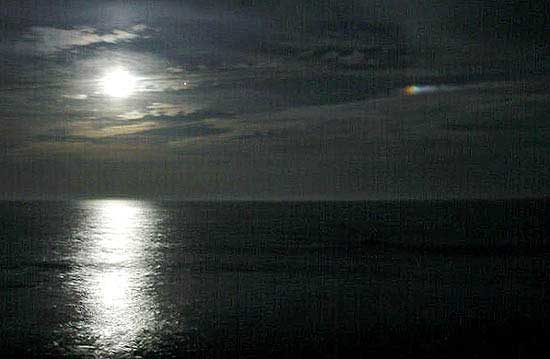
|
But let's first have a
look how it all started.
The origin of the moon.
The earth and her moon are the
strangest couple in our solar system; compared to the earth the moon is
actually far too big. The moons diameter is a quarter of the earths' .
You can equate that to Venus, which has no moon, and is almost the size
of the earth. Or what about Mars? This planet has two moons, but these
are no more than a couple of swirling rocks. No, moons like ours can
only be found orbiting super-planets like Jupiter or Saturn.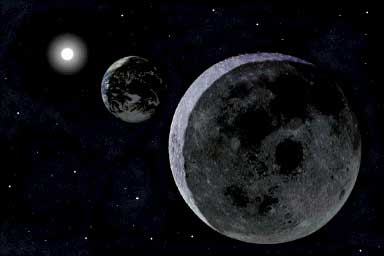
Most of the scientists agree: moon and earth didn't evolve at the same
time. The moon has its origin in a disastrous event taking place about
4.5 billion years ago; the earth was just born. At that time the other
smaller planetary bodies were also growing. One of these, about the
size of Mars, hit the earth. Most of the intruder evaporated, only the
core fused with Earth. Lots of earths' material was blown into space; a
dense ring of rocky debris went into orbit around the earth and finally
aggregated into the moon.
This sounds a fanciful and
unbelievable story, but computer simulations have demonstrated that
there's a big chance it happened this way.
In former days the moon and earth were much closer together, about
100.000 miles, and both rotated much faster around their axes than
nowadays.
During a very complicated game of gravity performed by Sun, Earth and
Moon; the latter two drifted apart and, at the same time,
turned more and more slow around their axes.
This process hasn't stopped yet. The distance between earth and moon
still grows; about 1,4 inches a year. But meanwhile the moon
is already "stopped" by the earth; and that's why we only see one face
of the moon.
In the very remote future, about 5 billion years from now, day and
night will last 1,5 times longer so "the space of 24 hours"
will take 36 hours.
The moons phases.
The moon is visible due to the
sunlight. The sun illuminates the moon and that's why we can see her.
As the moon turns around the earth she is not always fully visible;
actually the full moon appear only when she opposite 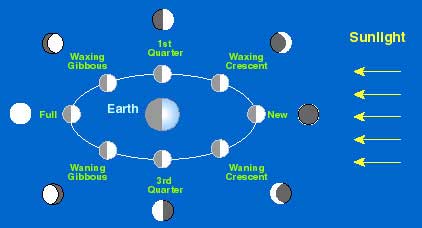 of the sun from the earth's
view. The other phases appear when she in another position of her
orbit. The figure will explain. of the sun from the earth's
view. The other phases appear when she in another position of her
orbit. The figure will explain.
The moons gravity
Naturally the moon brings a lot of
gravity to bear at the earth. You can notice when your spend a day at
the beach. Two third of the tides-movement is caused by the moon; the
rest is due to the Sun. Such tidal effects also take place in the
earth's atmosphere, but they're hardly measurable. It's estimated that
the differences in air pressure caused by tides is only
1 mbar or 1 hPa.
The moon and the weather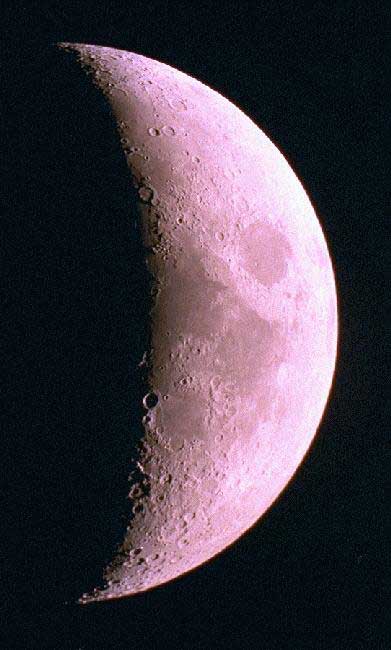
And this leads us directly to the
influence of the moon on our weather. For lots of people this influence
is taken for granted especially when the moon is full or new. When
rain's coming; my elderly neighbour always and invariably declares:
"Yes, naturally, its new moon".And what's more; many weather-proverbs
refer to the moon.
There are roughly two kinds of
proverbs:
- One group is about the visibility of
the moon -- colour, clouds -- in relation to certain
weather-conditions.
- The second group, and for this subject
the most interesting, is about the phases of the moon and
weather-conditions.
The first group: visibility of the moon
In proverbs like: " clear
moon, frost soon" or " a red moon is sure a sign of high
winds" the relation between the moon and the weather-conditions is
clear. But its not the moon that's influencing the weather; its
obviously the other way around; cause and effect are changed..
Naturally at wintertime there's a big change of frost during full moon.
A full moon is only visible when the sky is clear. And during clear
spells the radiation can be so strong that the temperature lowers below
zero.
Another factor are high or cirrus
clouds developing at higher levels in the atmosphere, mainly exciting
of ice-crystals. When these crystals are illuminated by the moon;
sometimes a halo will appear, forming a ring around the moon;
or she loses her familiar glance.
Cirrus clouds covering the sky often indicate a warm-front coming,
associated with an area of low pressure; which means a change to more
unsettled weather; with the usual rain and wind.
And then the charming picture about the new moon holding the old one in
her lap. When this is the case, the proverb says, you can expect fair
weather. Sometimes in a very thin new moon-crescent; the
shadow of the whole moon is visible as an outlined grey ball;
rising out of the tiny illuminated part. This visible grey moon-shadow
appears when the earth reflects her sunlight on the moon. The air must
be very clear and quiet; no turbulence in clouds to obscure. Its the
case in settled weather-conditions; very likely an area of high
pressure is around, the weather will be fair.
The second group: the phases of the moon
Its a widespread believe that
the four "strategic" moon phases (new- first quarter; full moon, last
quarter) can cause a break in the weather.
In our region the weather is pretty variable and it's hard to define
when you can speak about a break.
Besides that, every seven days a strategic moon phase is there; so the
changes that a chance in moon phase and a weather-break coincide is
fairly big. And this certainly counts when you're not so very
particular about the exact moment and the weather-break can take place
a day earlier or later.
Let's concentrate on the most
important proverb: " the heaviest rain falls following a new or full
moon" 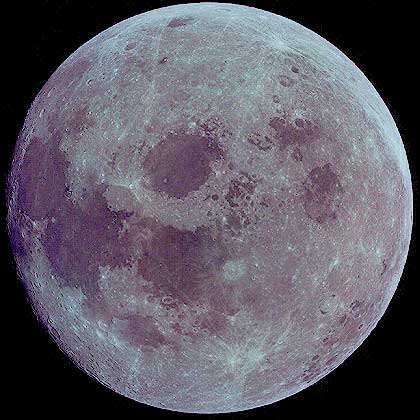
Meteorologists of the Dutch Meteoconsult has followed the weather
conditions around new and full moon, during three days -- so a day
before, during and after the moon phase. -- This research took places
during 100 new and full moons; so it took over 8 years --
.
To be short the test was this: the weather around every new and full
moon got a mark in the scale from 0 to 10. A clear improvement of the
weather (contrary to the proverb) got a "0" . When there was no change
a "5" was written down, and a deterioration got a "10". (After all: the
last situation is predicted by the proverb.)
When the theses is right the mean of all this marks must have been
high. Actually the mean was 5.1; exactly the result you can expect when
the weather doesn't care at all about the moon phases.
And the one who thinks logical and
down to earth, should be convinced that the moon phases can't influence
the weather.
Suppose that the weather really gets worse during new - or full
moon.
A full moon in Britain means a full moon around the globe.
It's not necessary to explain that a weather-deterioration in Britain
can't also mean a depreciation in the Alps or the Caribbean or
Australia.
And that the moon only would influence the weather in Britain is
absolutely inexplicable. Thankfully no search to such a strange
evidence is needed: it simply can't be true. There's no relation
between the moon-phases and the weather.
No
relation at all?
Actually the statement that there's absolute not a
relation is not entirely true; but the influence is very local and limited.
For example: Imagine coastal area's with proper sand or shoal beaches
(the Wash) and a fair tidal difference during a warm sunny summer-day.
There's a sea-wind; now the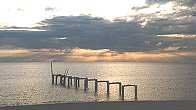 maximum-temperature along
the coast will be at the highest when the tide is low. The air is
warmed by the sandbanks and shoals which are fallen dry and heated by
the sun. The time of high- and low tides change every 24 hours about
three-quarters of an hour. The
maximum temperature of the day will correspond with the tides; and
therefore with the phase of the moon. In this very specific case
there's a relation between the moon and the maximum temperature. maximum-temperature along
the coast will be at the highest when the tide is low. The air is
warmed by the sandbanks and shoals which are fallen dry and heated by
the sun. The time of high- and low tides change every 24 hours about
three-quarters of an hour. The
maximum temperature of the day will correspond with the tides; and
therefore with the phase of the moon. In this very specific case
there's a relation between the moon and the maximum temperature.
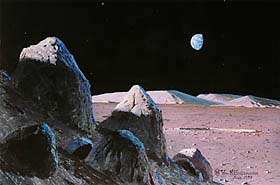
With thanks
to: meteoconsult, Holland
Photo's:
www.astrophotography.com
Mail to: wijke@scribeweekly.com
Archive of
Scribeweekly Weather Specials
|
 For many centuries she's a
source of inspiration: The Moon. A reliable beacon during the nightly
hours; always makes lovers' hearts beat faster and the moon can even
make you crazy -- so they say. And much more is ascribed to the
moon; according to lots of proverbs her colour and her
changing phases seem to have an influence on the
weather. Let's see what's the truth in all this:
For many centuries she's a
source of inspiration: The Moon. A reliable beacon during the nightly
hours; always makes lovers' hearts beat faster and the moon can even
make you crazy -- so they say. And much more is ascribed to the
moon; according to lots of proverbs her colour and her
changing phases seem to have an influence on the
weather. Let's see what's the truth in all this:

 of the sun from the earth's
view. The other phases appear when she in another position of her
orbit. The figure will explain.
of the sun from the earth's
view. The other phases appear when she in another position of her
orbit. The figure will explain.

 maximum-temperature along
the coast will be at the highest when the tide is low. The air is
warmed by the sandbanks and shoals which are fallen dry and heated by
the sun. The time of high- and low tides change every 24 hours about
three-quarters of an hour.
maximum-temperature along
the coast will be at the highest when the tide is low. The air is
warmed by the sandbanks and shoals which are fallen dry and heated by
the sun. The time of high- and low tides change every 24 hours about
three-quarters of an hour.